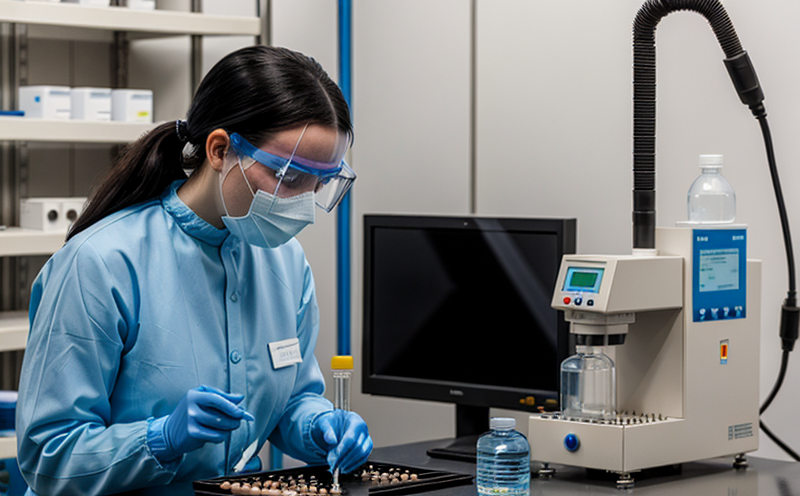XRD Crystallinity Testing
Crystallinity testing using X-ray Diffraction (XRD) is a critical analytical technique in pharmaceutical testing. This method is widely used to analyze the crystal structure of materials, which can significantly impact the performance and stability of drug products. In pharmaceuticals, understanding the crystalline nature of active ingredients or excipients is essential for ensuring product quality, efficacy, and safety.
The process involves exposing a sample to X-ray beams, which diffract according to the crystal structure's lattice planes. The resulting diffraction pattern provides detailed information about the crystallographic properties of the substance being tested. This includes identifying the type of crystal form (polymorph), crystallinity level, and impurity profiles.
Crystallinity is a measure of how much ordered or disordered structure exists within a material. In pharmaceuticals, higher crystallinity often correlates with better dissolution rates and bioavailability. Conversely, amorphous forms can offer advantages like improved stability but may be less effective in terms of dissolution kinetics. Therefore, precise quantification of crystallinity using XRD is crucial for optimizing drug formulations.
The testing procedure typically begins with thorough sample preparation to ensure accurate results. This involves grinding the sample into a fine powder and ensuring uniformity through sieving or other mechanical means. The prepared sample is then placed in the XRD instrument, which scans it across a range of angles, capturing the diffraction pattern.
The equipment used for this analysis includes high-resolution XRD instruments capable of detecting subtle differences in crystal structures. These systems are often equipped with advanced software that can interpret data and generate detailed reports on crystallinity levels and other relevant parameters. Compliance with international standards such as ASTM E1246 or ISO 19780 ensures consistent and reliable results across different laboratories.
The importance of XRD crystallinity testing extends beyond simply identifying crystal forms; it plays a key role in regulatory compliance, quality assurance programs, and R&D activities. Regulatory bodies like the FDA and EMA require comprehensive data on crystalline properties as part of new drug application submissions. By providing accurate and detailed information through this testing method, pharmaceutical companies can meet these requirements while also advancing their research efforts.
In conclusion, XRD crystallinity testing is an indispensable tool in modern pharmaceutical laboratories. Its ability to provide precise insights into the crystallographic characteristics of materials makes it a cornerstone of quality control measures across various stages of drug development and production processes.
Benefits
The primary benefit of XRD crystallinity testing lies in its capability to offer detailed information about the crystal structure of pharmaceutical compounds. This knowledge is invaluable for optimizing formulation design, improving manufacturing efficiency, and enhancing product quality assurance. Here are several key advantages:
Enhanced understanding of how different crystal forms affect drug performance.
Prediction of stability behavior under varying environmental conditions.
Achievement of optimal dissolution rates leading to better bioavailability.
Satisfaction of regulatory requirements with accurate, standardized data.
By leveraging XRD crystallinity testing, pharmaceutical manufacturers can make informed decisions that ultimately lead to safer and more effective medications for patients worldwide.
Industry Applications
| Application Area | Description |
|---|---|
Drug Substance Characterization |
Determining the purity and identity of active pharmaceutical ingredients (APIs), including identification of potential impurities. |
Crystal Form Stability Studies |
Evaluating how stable a particular crystal form is over time or under different storage conditions. |
Dissolution Rate Optimization |
Identifying crystalline phases that influence dissolution speed, which can impact drug efficacy and patient compliance. |
XRD crystallinity testing is particularly useful in these areas because it provides precise measurements of crystal structures. This data helps researchers understand not just what the compound looks like but also how it behaves under various conditions. For instance, knowing whether an API exists predominantly as its most stable polymorph can guide decisions about processing methods and packaging strategies.
Quality and Reliability Assurance
Ensuring high standards of quality and reliability is paramount in pharmaceutical testing. XRD crystallinity testing supports this goal by providing robust, repeatable results that meet stringent industry benchmarks. Here’s why this matters:
Absence of impurities can be quantified with precision.
Consistency between batches is maintained through consistent testing protocols.
Compliance with international standards ensures global acceptance and trustworthiness.
Pharmaceutical companies rely on such tests to build confidence in their products, which contributes directly to patient safety. The reliability of XRD data helps streamline supply chains by ensuring that every batch meets the necessary criteria before being released for clinical trials or commercial sale.
Incorporating XRD crystallinity testing into quality assurance protocols demonstrates a commitment to excellence and fosters long-term relationships with healthcare providers and consumers alike.





